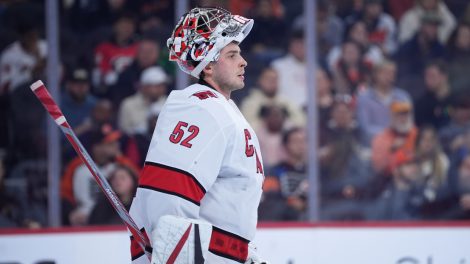Wasn’t the Super Bowl fantastic?
The final score was 41-33. Tom Brady threw for 505 yards — and still, it wasn’t enough. There were 54 first downs, only 10 by rushing. The game featured one punt.
“One punt!” marveled Milan Lucic, the former Boston Bruin and certified Patriots fan who nonetheless loved the game for its entertainment value.
The next night, hockey fans across Canada blew up Twitter with reaction to two events: Connor McDavid’s five-point night in Edmonton, and three-point games by Auston Matthews and William Nylander in Toronto.
Toronto won 7-4, Edmonton won 6-2, and for two nights at least, defence didn’t win a championship or a regular season NHL game. It was about offence, and it was awesome.
[snippet id=3816507]
“When’s the last time you saw a Super Bowl with 1,200 yards of offence?” asked Lucic (actually, it was 1,151). “One punt for the New England Patriots — and they lose the game? With Tom Brady and all those weapons that he has? Unreal!”
So how does hockey get there?
This season, according to hockey-reference.com, NHL clubs average 2.93 goals per game, up from 2.77 last season. An increase, yes, but bear in mind that scoring tends to fall in the stretch run, which will bring the final number down. In the end, one-tenth of a goal per game is an advancement – but that’s eight goals per season per team.
Whoopee.
Other than an aberration coming out of the lost season — 3.08 goals per game in 2005-06 — the last time NHL teams averaged better than 3.00 goals per game was 22 years ago: 3.14 goals per game in 1995-96.
We’re stuck in what is affectionately known as “a 3-2 league.”
“We hear about the race to three now?” said Oilers winger Mike Cammalleri. “The race to four or five would be a lot more fun.”
Last season McDavid was the NHL’s only 100-point scorer. In fact, it’s been eight years since the NHL saw multiple 100-point players in the same season. Of the four major North American sports, hockey is the only one unable to unlock its offence.
• In the NBA, teams average 105.7 points per game this season, compared to 99.9 a decade ago according to basketball-reference.com. They’ve limited hand checking and some zone defences to help offences thrive.
• In Major League Baseball, teams averaged 4.65 runs per game in 2017, down from 4.80 in 2007. However, MLB featured 6,105 home runs in ‘17 after having seen just 4,661 in 2013, according to baseball-reference.com.
• In the NFL, teams average 21.7 points per game in 2017 and 2007. But this past playoff season was an offensive bonanza, ending with the highest scoring championship game since 1995 and the second highest scoring game of all-time, according to pro-football-reference.com.
The NFL has limited defensive backs ability to contact receivers, and increased protection on quarterbacks. Hockey, meanwhile, has increased the ability of goalies to freely make saves, and reviews offside plays to kill off even more goals.
“Every coach and every system is based around defence, more than it is about creating offence, correct?” asked Lucic. “Look at the NBA versus college basketball. In the NBA they’re not allowed to play (certain types of) zone defence.
“I remember our game in New York, they were up 3-2 on us in the third period, they didn’t even try to score. They played a one-four. I was chirping one of the players on their team. ‘Are you serious? This is actually the way you’re playing right now? Not to lose?’”
The NHL has abjectly lost the battle on goaltenders’ equipment, a quarter century since Patrick Roy first debuted his Size 65 clown pants. The goalies union has played a shell game ever since, moving padding from one part of the body to another. Meanwhile, while McDavid and Matthews get slashed and whacked on breakaways, goalies annually lobby for more protection so they can eliminate scoring more efficiently, isolated from the contact every other player deals with.
And coaches? The only thing coaches care about is collecting points and holding their jobs. So what if we made the only path to points a more offensive one?
Why is it that hockey people require a loser point for an overtime or shootout loss, when football, baseball and basketball people can handle an extra-time loss that goes unrewarded?
Why are we so soft in hockey, that we require a participation medal for losing in OT?
[relatedlinks]
“You shouldn’t get a point for failure,” argues Lucic. “I know a lot of Americans, when they watch CFL football they don’t understand why you get a point for missing a field goal. A point for failure.
“Maybe go to a 10-minute three-on-three overtime, because I don’t see many games being tied after 10 minutes of three-on-three. But I agree 100 hundred percent: There shouldn’t be a point for failure.”
Cammalleri is a scorer. And, he’s a long-time member of the Competition Committee, a well-intentioned group whose potential impact has been vastly minimized by red tape and fillbustering.
“(Offence) is our main topic. We start with the hot button topics, but then the big topic is always that: scoring, and creating scoring,” said the career 292-goal scorer. “I’d like to see Connor and his class of player getting 40, 50, 60 points more than the next group of four or five. I think it’s good for sport if we could see Connor, Sid (Crosby), (Nathan) MacKinnon, (Nikita) Kucherov and whomever is up in that group, separate themselves by 20 or 30 points. That’s entertaining.”
Sunday was fabulously entertaining. Monday was every bit as entertaining.
But the stretch run begins soon. Then we’re back to the Race to Three.
Woo-hoo.








